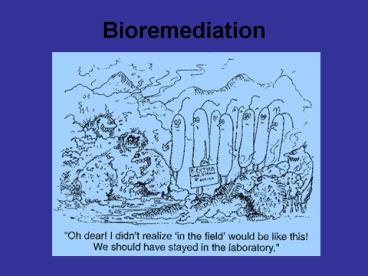Bioremediation - PowerPoint PPT Presentation
1 / 17
Title:
Bioremediation
Description:
Bioremediation Bioremediation Definition: Use of living organisms to transform, destroy or immobilize contaminants Goal: Detoxification of the parent compound(s) and ... – PowerPoint PPT presentation
Number of Views:1650
Avg rating:3.0/5.0
Title: Bioremediation
1
Bioremediation
2
Bioremediation
- Definition Use of living organisms to
transform, destroy or immobilize contaminants - Goal Detoxification of the parent compound(s)
and conversion to products that are no longer
hazardous to human health and the environment.
3
Forms of Bioremediation
- In situ Bioremediation
- Bioventing
- In situ biodegradation
- Biostimulation
- Biosparging
- Bioaugmentation
- Natural Attenuation
- Ex situ Bioremediation
- Land farming
- Composting
- Biopiles
- Bioreactors
4
Forms of Bioremediation
- Phytoremediation
- Phytoextraction or phytoaccumulation
- Phytodegradation or phytotransformation
- Phytostabilization
- Rhizodegradation
- Rhizofiltration
5
In Situ Bioremediation
- Bioventing
- One of the most common approaches in soil
- Supply air and nutrients via wells
- Takes advantage of indigenous microorganisms
- In situ biodegradation
- Supply air and nutrients by circulating aqueous
solutions through contaminated soils or
groundwater - Biosparging
- Injection of air below the water table ?
increases groundwater oxygen concentrations and
mixing in saturated zone - Bioaugmentation
- Addition of indigenous or exogenous
microorganisms - Limits to use competition and necessity
- Biostimulation
- Natural Attenuation or Intrinsic Bioremediation
6
Bioventing
7
Biosparging
8
(Monitored) Natural Attenuation
- Using the biodegradative capacity of indigenous
microbes without additional enhancement - Relies on combined biological (i.e.,
biodegradation), physical (i.e., volatilization,
dispersion, sorption), and chemical processes
(e.g., hydrolysis, oxidation, reduction) - Feasible only when the biodegradation rate is
faster than the rate of contaminant migration.
9
Ex situ Bioremediation
- Land farming
- Contaminated soil is excavated and spread over
land - Soil is periodically tilled to improve aeration
- Remediation due to indigenous microorganisms, as
well as chemical and physical processes - Generally limited to the superficial 1035 cm of
soil - Can reduce monitoring and maintenance costs
- Composting
- Combines contaminated soil with nonhazardous
organic amendants (e.g. manure or agricultural
wastes) - Biopiles
- Combination of landfarming and composting
- Control physical losses of contaminants
- Bioreactors
- Soil and water pumped up from a contaminated
plume and processed through an engineered
containment system - Degradation in a bioreactor is generally greater
than in situ because the contained environment is
more controllable and predictable
10
Feasibility/Effectiveness
- a function of
- Microorganisms
- Environmental factors
- Contaminant type state
11
Microorganisms
- Aerobic bacteria
- Examples include Pseudomonas, Alcaligenes,
Sphingomonas, Rhodococcus, and Mycobacterium - Shown to degrade pesticides and hydrocarbons
alkanes and polyaromatics - May be able to use the contaminant as sole source
of carbon and energy. - Methanotrophs
- Aerobic bacteria that utilize methane for carbon
and energy - Methane monooxygenase has a broad substrate range
- active against a wide range of compounds (e.g.
chlorinated aliphatics such as trichloroethylene
and 1,2-dichloroethane) - Anaerobic bacteria
- Not used as frequently as aerobic bacteria
- Can often be applied to bioremediation of
polychlorinated biphenyls (PCBs) in river
sediments, trichloroethylene (TCE), and
chloroform - Fungi
- Able to degrade a diverse range of persistent or
toxic environmental pollutants
12
Microorganisms
- Acclimatization and lag phase
13
Environmental Factors
- Nutrient availability
- Environmental Conditions
- Metal content
14
(No Transcript)
15
Phytoremediation
- Phytoextraction or phytoaccumulation
- Plants used to accumulate contaminants in the
roots and aboveground biomass - Can be a relatively low cost option for a large
area - Results in biomass that must be properly disposed
of or reused - Phytotransformation or phytodegradation
- Uptake of contaminants and transformation to more
stable, less toxic, or less mobile forms - Eg. metal chromium can be reduced from hexavalent
to less mobile (and non-carcinogenic) trivalent
chromium - Phytostabilization
- Mobility and migration of contaminants are
reduced through sorption onto or into the plant - Rhizodegradation
- Breakdown of contaminants through activity of the
rhizosphere - Rhizofiltration
- Water remediation technique
- Used to reduce contamination in natural wetlands
and estuary areas.
16
(No Transcript)
17
Five Steps of In Situ Bioremediation
- Site investigation
- 2. Treatability studies
- 3. Recovery of free product and removal of the
- contamination source
- 4. Design and implementation of the in situ
- bioremediation system
- 5. Monitoring and performance evaluation of the
in situ bioremediation system

